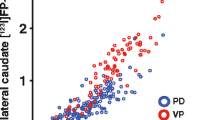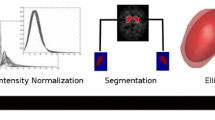Abstract.
Positron emission tomography (PET) and single-photon emission tomography (SPET) imaging of the dopaminergic system is a powerful tool for distinguishing groups of patients with neurodegenerative disorders, such as Parkinson’s disease (PD). However, the differential diagnosis of individual subjects presenting early in the progress of the disease is much more difficult, particularly using region-of-interest analysis where small localized differences between subjects are diluted. In this paper we present a novel pixel-based technique using logistic discriminant analysis to distinguish between a group of PD patients and age-matched healthy controls. Simulated images of an anthropomorphic head phantom were used to test the sensitivity of the technique to striatal lesions of known size. The methodology was applied to real clinical SPET images of binding of technetium-99m labelled TRODAT-1 to dopamine transporters in PD patients (n=42) and age-matched controls (n=23). The discriminant model was trained on a subset (n=17) of patients for whom the diagnosis was unequivocal. Logistic discriminant parametric maps were obtained for all subjects, showing the probability distribution of pixels classified as being consistent with PD. The probability maps were corrected for correlated multiple comparisons assuming an isotropic Gaussian point spread function. Simulated lesion sizes measured by logistic discriminant parametric mapping (LDPM) gave strong correlations with the known data (r 2=0.985, P<0.001). LDPM correctly classified all PD patients (sensitivity 100%) and only misclassified one control (specificity 95%). All patients who had equivocal clinical symptoms associated with early onset PD (n=4) were correctly assigned to the patient group. Statistical parametric mapping (SPM) had a sensitivity of only 24% on the same patient group. LDPM is a powerful pixel-based tool for the differential diagnosis of patients with PD and healthy controls. The diagnosis of disease even before clinical symptoms become apparent may be possible, and ultimately this technique could be most useful in differentiating between several neurodegenerative disorders, incorporating images of multiple neuroreceptor systems.
Similar content being viewed by others
Author information
Authors and Affiliations
Additional information
Received 8 April and in revised form 23 June 1999
Rights and permissions
About this article
Cite this article
Acton, P., Mozley, P. & Kung, H. Logistic discriminant parametric mapping: a novel method for the pixel-based differential diagnosis of Parkinson’s disease. Eur J Nucl Med 26, 1413–1423 (1999). https://doi.org/10.1007/s002590050473
Issue Date:
DOI: https://doi.org/10.1007/s002590050473




